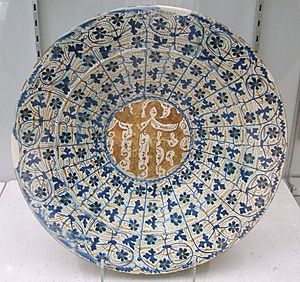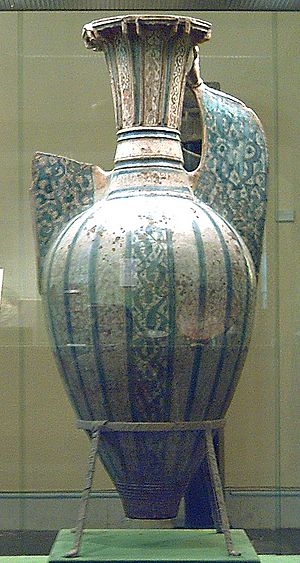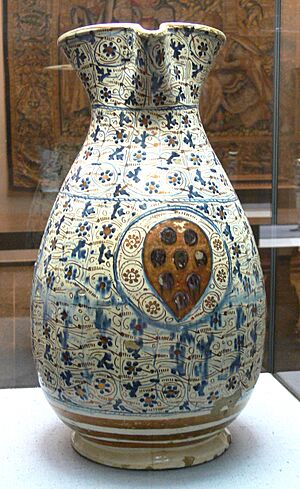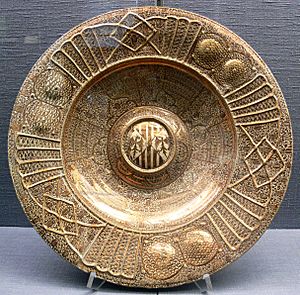Hispano-Moresque ware facts for kids
Hispano-Moresque ware is a special type of pottery. It started in Muslim Spain (called Al-Andalus) and continued to be made even after Christians took over. This pottery mixes Islamic and European art styles. It was the fanciest and most expensive pottery in Europe for a long time. It was even sent to many other European countries. This pottery was most popular in the 1300s and 1400s.
Around the year 711, a group called the Moors came to Spain. They brought two new ways to make pottery to Europe. One was using a white tin-glaze to make pottery shiny and opaque (not see-through). The other was called lustreware. This made pottery look like shiny metal with a rainbow-like shimmer. Hispano-Moresque pottery uses both of these methods. The special paint is put on top of the glaze and then fired in a kiln again.
Lustreware was a special skill of Islamic potters. This was partly because Muslim rules discouraged using gold and silver dishes. So, wealthy Muslims used beautiful pottery and glass instead. In Europe, rich Christians often used metal dishes.
At first, the main place for this pottery was Málaga in southern Spain. The designs were very Islamic. But by the 1400s, most of this pottery was made near Valencia. This area had been taken back by Christian rulers long before. Pottery from towns like Manises in Valencia was mostly made for Christian buyers. It was sent to many places far away.
Contents
Where Was This Pottery Made?
Pottery from Southern Spain (Andalusia)
The first big center for fine pottery in Al-Andalus was Málaga. This was the main place where beautiful pottery was made while the area was still under Muslim rule. Málaga was famous for its gold lustreware in the 1300s. It stayed under Muslim rule until 1487. This was just before Granada, the last Moorish kingdom, fell.
Other early pottery centers included Murcia, Almería, and maybe Granada. Pottery from these areas stayed closer to Islamic art styles. However, much of it was sold to Christian markets. You can see Christian family symbols (coats of arms) on many pieces.
Málaga pottery was known for its gold shine on white enamel. It also often had blue paint mixed with the gold lustre. This was put on a red clay that was common in the area.
Some experts include Málaga pottery when they talk about "Hispano-Moresque." Others do not. When people first studied Spanish medieval pottery, they knew about Valencia. But they knew little about the southern Al-Andalus centers. Over time, many pieces once thought to be from Manises were found to be from Málaga. This happened because of new discoveries and scientific tests of the clay.
Lustreware production likely began in the 1200s. It might have started when Egyptian potters came to Spain to escape problems in their homeland. This pottery was already being sent to other places. For example, some early pieces were used as decorations on churches in Pisa, Italy. In 1289, Queen Eleanor of Castile, who was from Spain, ordered "42 bowls, 10 dishes, and 4 earthenware jars of foreign colour" from Málaga. Málaga pottery was also sent to Muslim countries. Pieces have been found in places like Fustat (old Cairo).
Alhambra Vases: Giant Pottery
The most famous pieces from Andalusia are the Alhambra vases. These are very large vases made to stand in special spots in the Alhambra palace in Granada. They are unusual because they were only for decoration, not for everyday use. They are also the largest lustreware pieces ever found.
These vases are based on old jar shapes. But they are huge, standing about 115 to 170 cm (3.8 to 5.6 feet) tall. This is almost as tall as a person! They were made between the late 1300s and the 1400s. Each vase has different decorations and a slightly different shape. One expert said, "few other pots in the world make such a strong physical impression."
Today, all these vases are in museums around the world. Lustre tiles can also still be seen at the Alhambra. A unique large plaque, the "Fortuny Tablet," has a garden design. It also has writing praising a ruler named Yusuf III. Its design looks like some old Spanish carpets.
After 1418, the kingdom of Granada began to decline. The making of fine pottery seemed to stop around 1450. Even so, people in Valencia still used the name obra de Malequa ("Malaga work") for lustreware for a long time.
Pottery from Valencia
Valencia and its nearby towns, Manises and Paterna, became important pottery centers. Potters moved there from southern Spain. Valencia had been under Christian rule since 1238. Skilled potters had been moving there since at least the mid-1300s. In 1362, a church leader ordered floor tiles from Manises for the Pope's palace in France. These tiles were called "Malaga work," likely meaning lustreware. In 1484, a German traveler wrote about vessels "which are made by the Moorish potters."
The local lords of Manises, the Buyl family, helped these potters move there. They also helped sell the pottery. When Queen Maria of Castile wanted a large set of dishes in 1454, she wrote to the Buyl lord to arrange it. The Buyl family made a lot of money from selling pottery. The largest collection of Manises pottery found by archaeologists (outside Manises) was in Sluis, Netherlands. This town was part of the rich Duchy of Burgundy. Manises also had good clay and a special sand for glazes nearby.
Pottery from Catalonia
Barcelona in Catalonia, northeastern Spain, became a pottery center much later. It was under Muslim rule from 718 to 801. It likely got Christian potters who moved from Al-Andalus, especially Valencia. Barcelona was first known for brown and green pottery. In the 1500s, it made lustreware with a "warm silvery-gold" color. This might have been due to different materials or a new style. Other towns also started making lustreware around this time.
Artistic Style and Designs
Much of the pottery, especially from Valencia, was made for Christian buyers. It often had Christian symbols like coats of arms. The dish shown at the top of this article has the Christian "IHS" symbol. Its vine-leaf design comes from Gothic art, perhaps from decorated books.
No pieces have been signed by the artists, and very few are dated. So, family symbols (heraldry) are important for figuring out when pieces were made. These pieces "had to be spectacular and elegant." Each type of dish had a special use. On big occasions, all the dishes might be used. The largest platters were often displayed upright on sideboards, as seen in old paintings.
Andalusian designs use many geometric shapes. Many of these probably had a religious meaning that Christian buyers did not know. These shapes were usually put into painted sections. Fake Arabic writing (Pseudo-Kufic) was used, as well as real Arabic words. Gold and blue were the main colors, perhaps representing the sun and sky. Other colors like brown, green, and yellow were used less.
Around 1400, some designs, like animal pictures, became popular with local Muslim buyers too. Two of the later "Alhambra vases" have pairs of gazelles. By then, the Muslim kings of Granada even had their own family symbols, like Christian rulers. These symbols also appeared on pottery.
Many large Valencian dishes have complex designs with a coat of arms in the middle. The underside often has bold animal figures that fill the whole space. These animals were also often taken from family symbols. One expert wrote about Manises pottery: "the sustained production of fine pieces at Manises during the years 1380–1430 is without parallel in the history of ceramics. Many of these vessels will keep their place among the world's finest pottery for ever."
In the 1400s, Hispano-Moresque pottery came in many shapes. These included the albarello (a tall jar) and large serving dishes with coats of arms. These were made for rich people across Europe. There were also jugs, deep dishes, and bowls with handles. Hispano-Moresque pottery greatly influenced early Italian maiolica. Towards the end of the 1400s, designs started to copy European metalware, with raised parts. Tiles were made in all centers. A small ceramic tombstone from 1409 is one of the few pieces that can be dated exactly.
One expert, Albert Van de Put, divided the decorative patterns into ten groups. These included different kinds of Arabic-like writing, flower and leaf patterns, and wavy designs.
Decline and Revival
The Christian Reconquista took Valencia for the last time in 1238. Málaga was one of the last cities to fall in 1487. The remaining Muslim people (Mudéjar) and those who converted to Christianity (Morisco) were forced to leave Spain in 1496 and 1609. The 1609 expulsion removed a third of the population in Valencia province.
However, many of the pottery makers had already become Christians. So, the Hispano-Moresque style continued in Valencia, though its quality dropped right away. Later pottery often had a rough, reddish body, dark blue decorations, and lustre. By this time, it was no longer the most respected pottery in Europe. Italian and other potters had taken its place.
One expert, Alan Caiger-Smith, said that the Valencian pottery industry became a victim of its own success. At first, the pottery was made for the very richest people, often custom-made with their family symbols. But as more people, like the growing middle class, wanted it, the size of the pieces and the quality of the decoration went down. The painting became simpler and more repetitive. The Italian maiolica industry grew by copying Spanish pottery. But the Italians were more creative and tried new things that Valencia did not.
Pottery continued to be made, but its quality slowly declined. It relied on local demand for tiles and other decorated items. Around 1800, there were still thirty working kilns in Manises. By then, people had already started trying to bring back the old glory of the industry. The secrets to making high-quality pottery were mostly lost. In 1785, a report was ordered to record the methods still being used. By the 1870s, people wanted pieces that looked like the old ones. New companies were started, and some still exist today. However, little new art is made in the old tradition.
Other Uses of the Term
The term "Hispano-Moresque" is also used for patterned silk fabrics made in Al-Andalus. Sometimes, it refers to other art forms like carpets. The carpet industry in Spain followed a similar path to pottery. The Metropolitan Museum of Art uses the term for a gilded helmet in its collection.
See also
 In Spanish: Cerámica andalusí para niños
In Spanish: Cerámica andalusí para niños
- Talavera de la Reina pottery








